 |
  |
 |
  |
Odissi Guru Kelucharan Mohapatra Info & pics courtesy: Srjan September 10, 2009 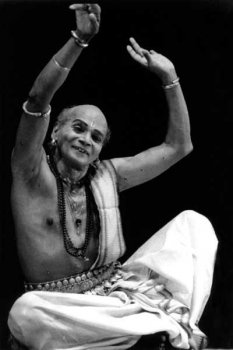 Odissi dance Guru Kelucharan Mohapatra born on 8 January 1926 at Raghurajpur, Puri, is among the many gems that Orissa has produced in different fields of art along the centuries. As is the case with most of the geniuses, who emerge from time to time in the history of humanity, the story of his life is one of struggle and unending dedication. The story of his artistic experiences touches all the salient features of the cultural life of Orissa of the last sixty years and it becomes the story of the growth and recognition of Odissi style as one of the classical dances of India. From the traditional expertise of the Chitrakaras through the entertaining art of the Gotipua and Jatra parties, the bhakti oriented rasa leela performances and the innovative attempts of the Annapurna Theatre, Kelucharan's artistic journey is one of continuous learning and growth. Gifted as he was with a highly sensitive, respectful and creative disposition, he observed and absorbed facts and phenomena of life around and transcreated them into forms of aesthetic beauty. The two currents of art present in his family, the traditional painting skill of the Chitrakaras, and the rich and vibrating musical tradition of the percussion players, were happily blended in him. By giving plastic dimension to the first he infuses life into it through the second. The tradition of Chitrakaras is a cultural heritage that is handed down through images; images that convey ancient legends in a universally understandable medium of communication. But the world of little Kelucharan was not merely populated by visuals, it was also pulsating with the vigorous rhythm of Sankirtana and Jatra (folk theatre) which used to be regularly performed in his native village Raghurajpur, a small hamlet in Puri district. In the evenings, little Kelucharan could be found in one of the two Akhadas in the village, watching and imitating the dance movements of the boys under training or trying his hand at reproducing the rhythm of the Pakhawaj on his own hips! His father, Chintamani Mohapatra, himself a painter and a mrudanga player, did not encourage his son's interest in the effeminate art of Gotipua dance, and to stop his son from going any more to the Akhadas of Balabhadra Sahu, he virtually abandoned him with Mohan Sunder Dev Goswami, the founder director of the famous Kunja Behari Rasa Leela party in Puri. Here, at the age of nine, Kelucharan began to soak up experiences which were to leave an indelible stamp on his entire life. During the ten years stay with Guru Mohan Goswami, he learnt not only acting, mime and singing but also the art of make-up, stage setting and choreography. The working day began early morning with training in singing and rhythm and closed with lessons in the communicative art of abhinaya in the evening. During the day the students, who lived together, also attended to the household chores, like cooking and cleaning, and dedicated themselves to various sevas for the Guru. The troupe used to keep moving on tour, giving performances in villages and towns for about 6 to 7 months a year and the remaining time was utilised in training and rehearsals for the coming season. The shows, an amalgam of song, and histrionics, were woven around the theme of Krishna-Leela or episodes culled from the Puranas. Mohan Goswami's choreography, with music and stage setting planned entirely by him, was famous in his time. Among the more popular creations of his were 'Balyaleela,' 'Mana Bhanjana,' 'Sharada Leela,' 'Radha Premamruta' and 'Bidagdha Madhava' built around various poems of Kavisurya Upendra Bhanja, Banamali, Gopal Krushna and Jaydev. Guru Mohan Goswami played an important role in his life. The Guru was a father and a protector to him. The multi-faceted versatility of Mohan Goswami was seen in Kelucharan Mohapatra too, both having the same extraordinary spell over their own disciples. For about a year after leaving the Rasa Leela party he had to battle hard to earn a living. With no fixed source of income he worked as a daily labourer, watering and carrying sand for the maintenance of betel groves. This struggle for survival eased somewhat when he found a job in Cuttack with the Theatre Company of Kalicharan Pattnaik for Rs.7 a month. His job was to help stage setting, act and play percussion instruments. 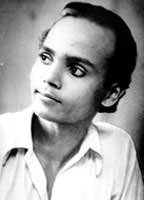 Kelucharan was under the able tutelage of Agadhu Moharana in mrudanga and Kshetramohan Kar in tabla training during his days with the theatre party of Mohan Goswami and he did not stop there. In Cuttack, he continued to take lessons in tabla playing from Harihara Rao. Initially contracted as an accompanist for only a month, he stayed with the Annapurna 'B' theatre of Cuttack for about five years from 1946 to 1952 distinguishing himself as a dancer, percussionist and choreographer. The real break came when a solo piece in a dance-drama on 'Devi Bhasmasura' brought Kelucharan into the limelight. His brilliant performance as Nataraja under the direction of Guru Pankaj Charan Das, established him as a mature soloist. In the role of Mohini was Laxmipriya who later became his wife. From that day till they married, in all performances either they were partners in a duet dance sequence or Laxmipriya would dance to the rhythm provided by Guruji. Always under the guidance of Guru Pankaj Charan Das and Guru Durlav Chandra Singh (in theatre), the pair became famous for their performances of the Dashavatara dance which was dovetailed into the legendary drama 'Sadhaba Jhia' in 1947. During this period, young Kelucharan also had the benefit of learning from Guru Dayal Sharan of the eminent Uday Shankar troupe, under whose influence he further enriched his expressive vocabulary. The training comprised the use of the various Shastric mudras as well as exercises on physical flexibility and techniques typical of the Uday Shankar ballets. This novel training coupled with his earlier experience, earned him success in his maiden directorial production of the dance-drama 'Aloka' with Laxmipriya in the central role. After directing three dance-dramas in mixed technique, when he was around 28, they both left the Annapurna 'B' group, got married and went back to Puri. There he spent a couple of years doing research on both the Mahari and Gotipua traditions of Odissi dance, imbibing according to his own words, "the spirit of devotion from the first and the technique from the other." The toil of this study found creative expression in his first Odissi composition for the role of Kalavati played by Laxmipriya in the Upendra Bhanja Nataka staged by the Annapurna theatres ('A' group) of Puri. 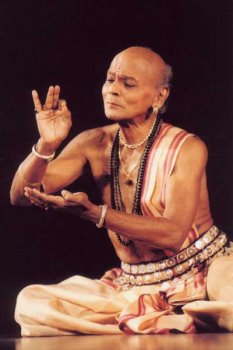 All along, he provided brilliant and mellifluous percussion accompaniment, both on tabla and mardala, for a number of musical broadcasts by All India Radio Station, Cuttack. By now, Kelucharan was well equipped to teach Odissi dance and in 1953 he joined the Kala Vikas Kendra at Cuttack, the first college of music and dance to include a course on Odissi in its curriculum. He taught there for more than fifteen years. Besides working in the Kendra, he used to impart lessons privately to some disciples including Sanjukta Panigrahi, Minati Mishra and Priyambada Hejmadi and was taking dance classes in some schools and colleges of general education. During these years, he choreographed a number of dance-dramas in Odissi style, including 'Panchapuspa,' 'Krushna Gatha,' 'Geeta Govinda,' 'Urbashi,' 'Krushna Leela,' 'Sakhigopal,' 'Konark' and 'Sri Kshetra.' Supported by the Kendra, he did research on various folk and tribal dances of Orissa and enriched his repertory of Odissi dance poses through further study of temple sculptures especially those found on the Brahmeswara, Parasurameswara and Konark temples. While involved in this process, his individual style was gradually taking a distinct shape and simultaneously became systematic and precise. These are the years when the first Pallavi in ragas Vasanta, Shankaravarana, Kalyani, Mohana, Saveri and Aravi and the first Ashtapadis from Geeta Govinda like Lalita Lavanga Lata, Sakhi He, Dhira Samire, Yahi Madhava, were composed. In the eighties, after leaving the Kala Vikas Kendra, Kelucharan Mohapatra travelled assiduously to different cities of India to be able to teach and spread Odissi dance, as far and wide as possible. He became a regular visiting teacher for the Gandharva Mahavidyalaya in Delhi, for the National Centre for the Performing Arts in Mumbai and for the Padatik Dance Centre in Calcutta. The number of his students kept on multiplying and when he was not teaching them in their respective towns, they would come, especially in the summer months to learn from him at his house in Cuttack. By now Kelucharan Mohapatra would start to reappear on stage as a solo performer and leave the audience spellbound by the sensual beauty and naturalness of his interpretations of the character of Radha from the Geeta Govinda, of the fisherman Kaibarta from the Ramayan and of Krishna from innumerable Oriya songs. Compared with Nijinsky for his "magnificent sinuous torso and arms" and with Chaplin for his "most inspired gestural acting" by American critics, Kelucharan had by now danced not only in India but all over the world, participating in the festivals of India in London, Russia, Germany, France, America and Japan. 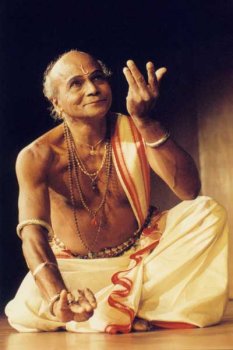 His compositions in raga Bagesri, Khamaj, Kirwani, are noteworthy for their intricate rhythmic structures which speak eloquently of his choreographic ability as well as his mastery over mardala (Pakhawaj) playing. With his quicksilver wizardry, the sound of the mardala was no longer relegated to be a mere support to the dance but came forth as a leading element. For ten long years, Kelucharan was associated with Odissi Research Centre in Bhubaneswar and made invaluable contributions to the work of codification and systematisation of the Odissi style which was the mandate of the institution. After leaving the Centre in 1995, he fully concentrated on developing Srjan - the dance academy founded by him and his wife and directed by his son Ratikant. Kelucharan Mohapatra was a keen hobbyist and one of his favourite pastimes was to play around with brick and mortar and build something almost entirely by himself. As in dance, likewise in this hobby, he was skilled and very focussed. His favourite materials were bricks and cement with which, between one choreography and another, he built his first house in Cuttack and intended to build there, the new Centre for his dance academy. He was in fact on a bamboo scaffolding busy plastering a wall of the new portion of his house when the telegraphic message conferring the Central Sangeet Natak Akademi Award reached him, in 1966. Unable to decipher the telegram in English, he got a neighbour to read it for him. Thus, he came to know that he had become the first Odissi Guru to get this distinction. The honor conferred on him, also meant recognition extended, at last, to Odissi dance as a classical form. 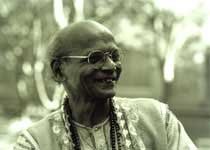 The title of Padma Shree came a few years later in 1975 and in 1981 he was conferred a Doctorate by the Akhil Bharatiya Gandharva Mahavidyalaya. He won the Kalidas Samman awarded by the Madhya Pradesh Government in 1987 and the title of Padma Bhushan in March 1988; the Padma Vibhushan was conferred on him by the President of India in March 2000 and Shankardev Award of Govt. of Assam by the Prime Minister of India in March 2001. In spite of the many honours received, the amount of work produced (he has over 200 solo compositions and about 50 dance dramas to his credit) and the number of students who hail from all over the world, Kelucharan Mohapatra never lost his simplicity and childlike purity: he let his greatness sit lightly on his shoulders, and carried his genius playfully with him. For him dance was "sadhana" and teaching was "dharma." He used to say, "Hundreds of my students are dancing today and I feel as if I am dancing in all their beings. Only when nobody can take my dance or my art further will I experience sadness." Srjan symbolises his humble offering of the classicism of Odissi dance, music and percussion to our rich national ethos. Dance is not the only concern of this institution. Without much external funds coming in Srjan has managed to achieve substantial progress with various schemes like scholarships to needy students; the Guru Kelucharan Mohapatra Award to a distinguished person in the field of performing arts (namely dance, theatre, music and cinema); maintaining a high level repertoire group, the artistes (of multiple age-groups) of which are paid by the institution; video and print archive with unique compositions of Guruji and live recordings of teaching sessions in progress, a well equipped library and many other accessories. A separate dance school and repertoire group functions under the aegis of Srjan Kolkata Chapter since Jan 2005 and organizes the Yuva Prativa Samman as part of the annual Deesha festival of two days of Odissi dance, where an accomplished young dancer is presented with a cash award and cost free dance training sessions for one calendar year. The man who spent a life time grooming disciples of the caliber of Sanjukta Panigrahi, Kumkum Mohanty, Sonal Mansingh, Madhavi Mudgal and countless others, one who started life as an impoverished mason and rose to merit a Padma Vibhushan award, breathed his last at the age of 79 on April 7, 2004, having lived a life enriched by the constant need to create aesthetic beauty in dance and in everything else he touched. Devotion and dedication ran through the life and art of Guru Kelucharan Mohapatra. Each action in his life as in dance was a continuous offering at the lotus feet of Lord Jagannath. Odissi dance in the hands of this great master climbed to new and dizzy heights, and became a universally admired art form through which he humbly and sincerely paid his devoted service to divinity. |